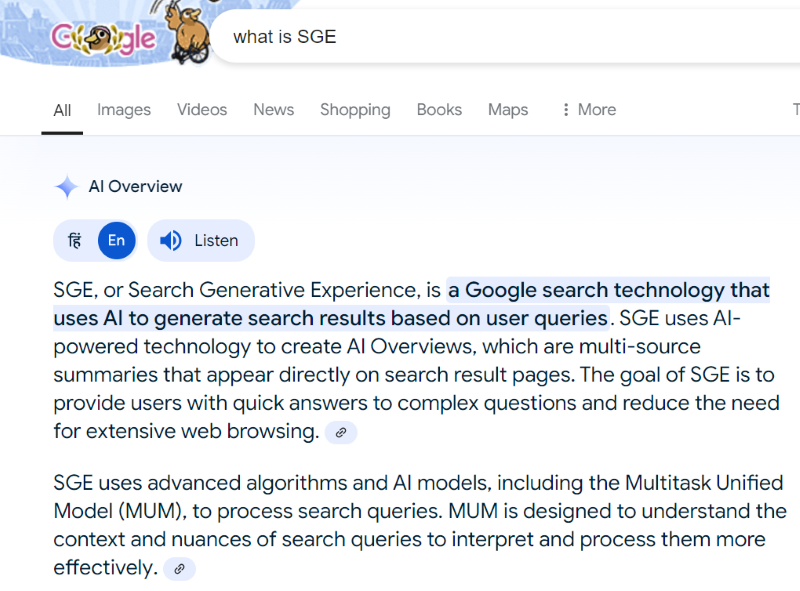The AI Takeover: Google’s New Update is Pushing Your SEO Strategy to the Brink—Here’s How to Stay on Top

Google’s recent AI update has sent shockwaves through the SEO community. The new AI Overview is more than just a feature—it’s a fundamental shift in how search engines prioritize content. As Google’s AI continues to evolve, so must our strategies. For businesses and content creators, the challenge is clear: adapt or risk being left behind.
At Digital Experience.Live, we’re committed to helping you navigate these changes. While traditional SEO tactics still hold value, the rise of AI requires a fresh approach. Here’s how you can future-proof your SEO strategy in the age of AI.

The New Reality: AI Overview and Its Impact on SEO
The AI Overview at the top of search results is now a permanent fixture. By aggregating and summarizing content from top pages, it’s pushing organic listings further down the page. For businesses relying on search traffic, this can be a significant blow. However, this challenge also presents an opportunity to rethink and innovate your approach to SEO.
Advanced Strategies to Thrive in Google’s AI Era
While the basics of SEO remain relevant, the AI-driven landscape demands more sophisticated strategies. Here are some advanced tactics to ensure your content remains visible and competitive:
Embrace Topic Clustering and Pillar Content
AI algorithms thrive on context and interconnectedness. By organizing your content into topic clusters with a central pillar page, you create a web of related content that signals to Google that your site is an authority on a particular subject. Pillar content acts as a comprehensive guide on a broad topic, while cluster pages delve into specific subtopics. This structure not only enhances user experience but also makes it easier for Google’s AI to understand and prioritize your content.
Optimize for Conversational AI and Voice Search
With the rise of voice-activated devices and conversational AI, optimizing for voice search is no longer optional. Voice search queries tend to be longer and more natural-sounding than text queries. To capitalize on this trend, incorporate natural language processing (NLP) techniques into your content strategy. This means anticipating the kinds of questions users might ask and providing direct, conversational answers. Additionally, consider incorporating long-tail keywords that mirror how people speak rather than how they type.
Prioritize Real-Time Content Updates
In an AI-driven world, fresh and relevant content is key. Google’s AI is increasingly favoring content that is regularly updated and reflects the latest information. Implement a system for real-time content updates, particularly for pages that target competitive keywords or are critical to your SEO strategy. This could involve setting up alerts for industry news, trends, and updates that could impact your content, ensuring it remains current and valuable to users.
Leverage User-Generated Content (UGC) and Engagement Signals
AI not only analyzes the content itself but also how users interact with it. User-generated content, such as reviews, comments, and social media posts, can be a goldmine for improving your SEO. UGC not only enriches your site with fresh content but also provides Google’s AI with valuable engagement signals. Encouraging user interaction on your site, whether through comments, forums, or social media integration, can enhance your content’s relevance and boost its chances of being featured in the AI Overview.
Integrate AI-Generated Content with Human Insight
While Google’s AI is getting better at understanding content, there’s still a significant role for human insight. Consider integrating AI-generated content with human expertise to create a hybrid approach. Use AI tools to analyze data, identify trends, and even generate draft content, but ensure that the final product is refined by human editors who can add nuance, context, and creativity. This approach can help you produce high-quality content at scale while maintaining the depth and accuracy that AI alone can’t achieve.
Focus on Visual Search and Multimedia Optimization
As AI becomes more sophisticated, visual search is gaining traction. Google’s AI can now recognize and categorize images, videos, and other multimedia content with greater accuracy. To stay ahead, optimize your multimedia content by using descriptive file names, alt tags, and captions. Additionally, consider creating video content that answers common queries in your niche, as videos are increasingly being featured in AI-generated summaries and search results.
The Road Ahead: Staying Agile in a Changing Landscape
Google’s shift to AI is a sign of things to come. As search engines continue to evolve, so must our SEO strategies. The key to success in this new era is agility—being able to quickly adapt to changes, experiment with new tactics, and stay informed about the latest developments in AI and search.
At Digital Experience.Live, we’re dedicated to keeping you ahead of the curve. While the AI Overview may seem like a hurdle, it’s also an opportunity to refine your SEO strategy and ensure that your content remains visible, relevant, and competitive.
Google’s AI update is not just a challenge; it’s an invitation to innovate
The future of SEO lies in understanding and adapting to the rise of AI. By embracing advanced strategies like topic clustering, conversational AI optimization, real-time updates, and multimedia enhancement, you can ensure that your SEO strategy remains robust in this new era of search.
Stay tuned to Digital Experience.Live for more insights and updates as we continue to explore the impact of AI on the digital landscape. Together, we can navigate these changes and keep your content at the forefront of search.




